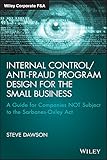Internal control/anti-fraud program design for the small business : a guide for companies not subject to the Sarbanes-Oxley Act / Steve Dawson.
Material type: TextSeries: Wiley corporate F & APublisher: Hoboken : Wiley, 2015Description: 1 online resourceContent type:
TextSeries: Wiley corporate F & APublisher: Hoboken : Wiley, 2015Description: 1 online resourceContent type: - text
- computer
- online resource
- 9781119083726
- 1119083729
- Sarbanes-Oxley Act of 2002 (United States)
- Fraud -- United States -- Prevention
- Small business -- United States -- Auditing
- BUSINESS & ECONOMICS / Auditing
- Fraud -- Prevention
- Small business -- Auditing
- United States
- Fraud -- United States -- Prevention
- Sarbanes-Oxley Act of 2002 (United States)
- Small business -- United States -- Auditing
- BUSINESS & ECONOMICS / Industrial Management
- BUSINESS & ECONOMICS / Management
- BUSINESS & ECONOMICS / Management Science
- BUSINESS & ECONOMICS / Organizational Behavior
- 658.4/73 23
- HV6691
- BUS003000
Includes index.
"This book covers all elements of an internal control structure applicable to the small business community. It is intended for those businesses for which the Sarbanes-Oxley Act does not apply (non-public businesses). Fraud cases are used throughout the book that provide an analysis of the internal control weaknesses that led to a specific fraud. Each case study also includes relevant controls that could have served to reduce the probability of the occurrence of the fraud. The controls are then summarized according to the five elements of an internal control structure for purpose of assisting in documenting the ultimate anti-fraud program. The steps provided in this book provide readers with a "how to" design and implement an effective and efficient internal control structure/anti-fraud program tailored to their specific needs"-- Provided by publisher.
Description based on print version record and CIP data provided by publisher.
Internal Control/Anti-Fraud Program Design for the Small Business; Contents; Preface: Maybe It's Time We Get Back to the Basics; Anti-Fraud Program Design for the Small Business; Small Business Defined; The Public Company versus the Nonpublic (Private) Company; Why the Distinction?; We Get It; We Need to Try to Prevent Fraud-So How Do We Do This?; The Anti-Fraud Program Structure; Acknowledgments; PART I: THE ANTI-FRAUD ENVIRONMENT: THE BLUEPRINTS, THE FOUNDATION, THE GROUND FLOOR; Chapter 1: The Architect's Blueprint: Establishing the Framework; The Elements of Anti-Fraud Program Design
Anti-Fraud EnvironmentFraud Risk Assessment; Control Activities; Information: Program Documentation; Communication: The Company Fraud Training Program; Monitoring and Routine Maintenance; Chapter 2: Foundational Policies: The Fraud Policy; Foundational Policies; The Fraud Policy: The Essential Elements of an Effective Fraud Policy; Element 1. Policy Statement; Element 2. Scope; Element 3. Actions Constituting Fraud; Element 4. Nonfraud Irregularities; Element 5. Reporting Structure; Element 6. Investigation Responsibilities; Element 7. Authorization for Investigation
Element 8. Acting in Good FaithElement 9. Whistle-Blower Protection; Element 10. Suspension or Termination; Element 11. Acknowledgment and Signature; Case Presentation; Chapter 3: Foundational Policies: The Fraud Reporting Policy; The Essential Elements of an Effective Fraud Reporting Policy; Element 1. Policy Statement; Element 2. Scope; Element 3. Reportable Actions Constituting Fraud; Element 4. Predication; Element 5. Reporting Mechanism; Element 6. Acknowledgment and Signature; Chapter 4: Foundational Policies: The Expense Reimbursement Policy; Case: "No Questions Asked"
Case: "It Will Never Be Missed"Case: Larry the Chief Financial Officer; The Elements of an Effective Expense Reimbursement Policy; Element 1. Policy Statement; Element 2. Scope; Element 3. Authorized Uses; Element 4. Unauthorized Uses; Element 5. Violations; Element 6. Documentation; Element 7. Statement of Responsibility; Appendix 4A: Expense Report Form; Appendix 4B: Supplemental Business Meal and Entertainment Charges Form; Chapter 5: The Ground Floor: The Fraud Risk Assessment Process; Ground Rules for Fraud Risk Assessment; Rule 1. Don't Be Misled; It's Not as Hard as It Seems
Rule 2. Place What You Know on the Back Burner, and Think the UnthinkableRule 3. Whether You Like It or Not, You Have to Think Like a Criminal; Rule 4. Don't Overdocument the Process; An Example of Risk Assessment; Procedural Steps for Performing a Fraud Risk Assessment; Understand the Guiding Principles; Determine the Participants; Determine How Information Will Be Gathered; Identify Areas of Fraud Risk; Cash in Bank; Case: The Trail Is Gone; Case: Friends in Low Places; Asset Misappropriation; Corruption; Financial Statement Fraud; PART II: ANTI-FRAUD CONTROL ACTIVITIES: RAISING THE WALLS
Media and Communication
